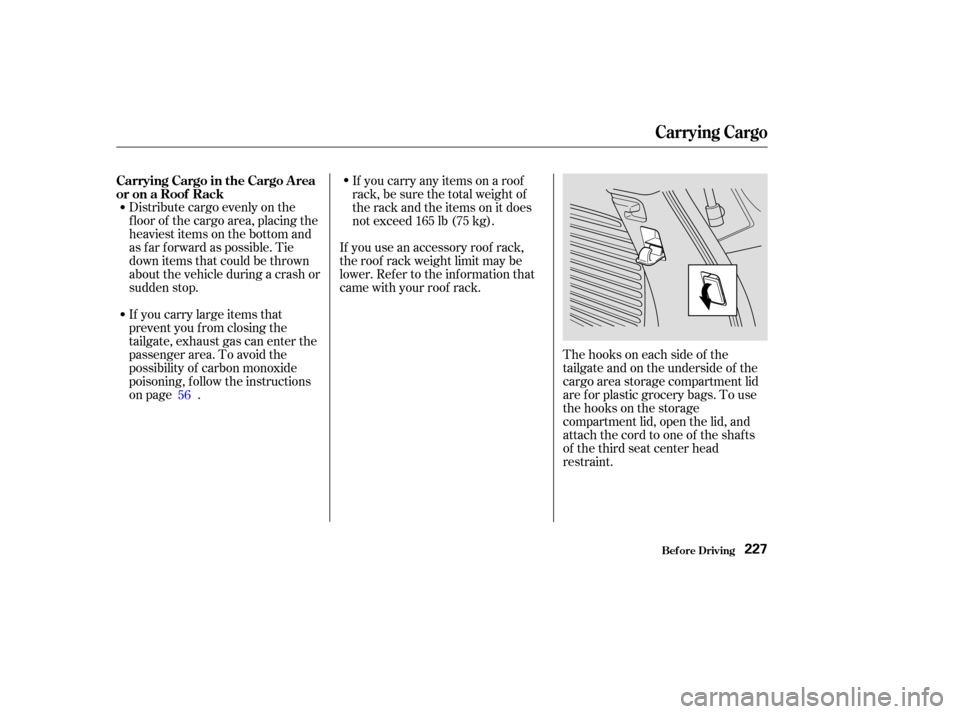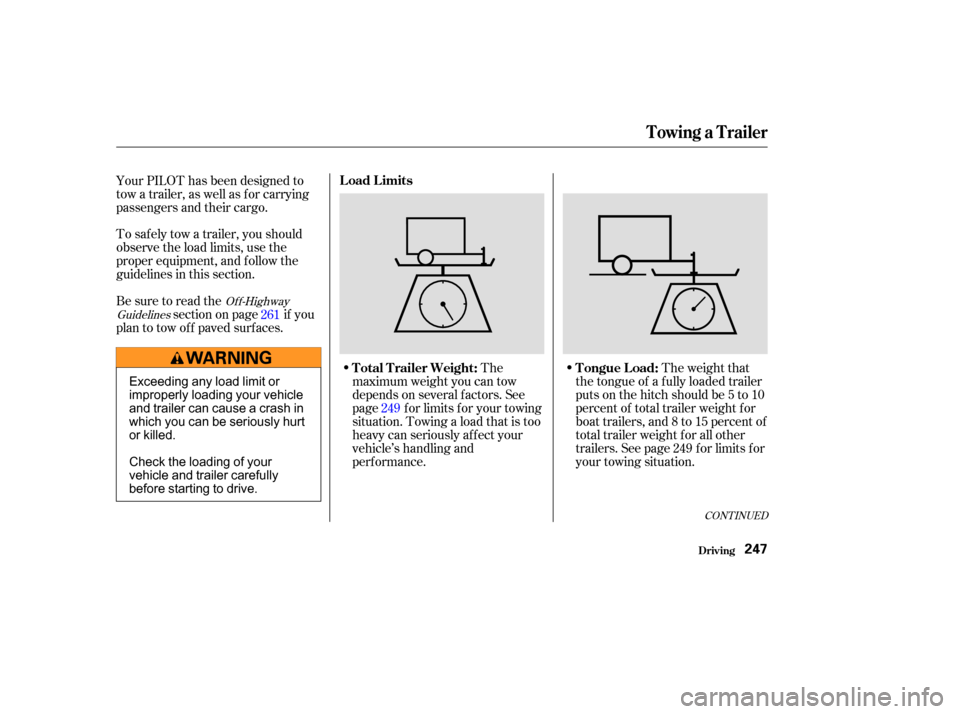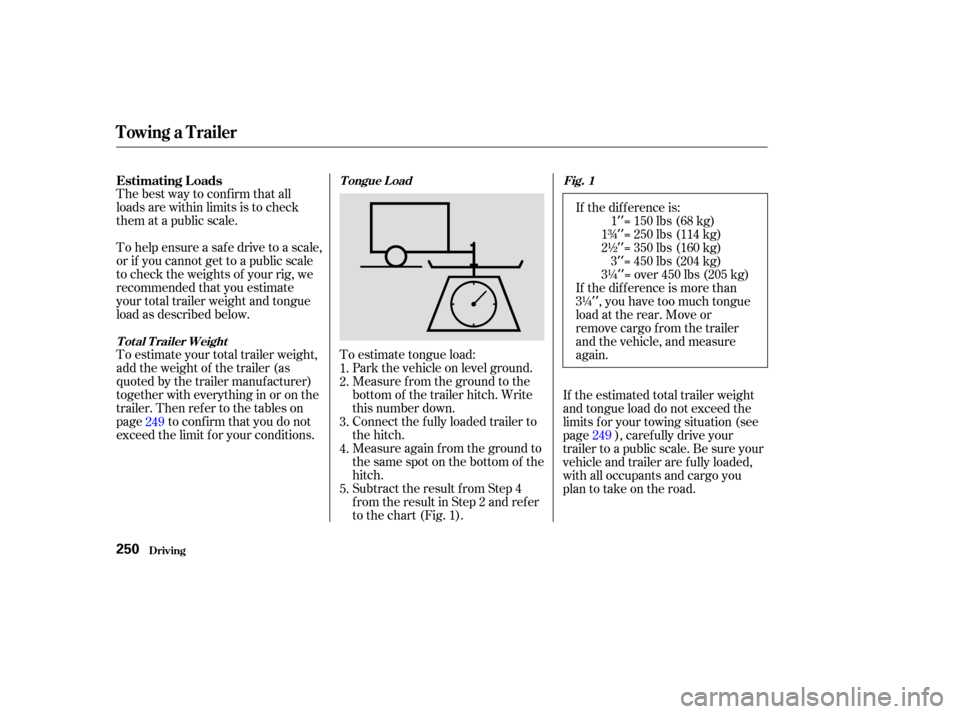Page 230 of 392

Store or secure all items that could
be thrown around and hurt
someone during a crash.
Be sure items placed on the f loor
behind the f ront seats cannot roll
under the seats and interf ere with
the driver’s ability to operate the
pedals, or with the proper
operation of the seats.
Keep the glove box closed while
driving. If the lid is open, a
passenger could injure their knees
during a crash or sudden stop.
This f igure includes the total weight
of all occupants, cargo, accessories,
and the tongue weight if you are
towing a trailer.
The f inal number is the total weight
of cargo you can carry.
If you are towing a trailer, add the
tongue weight to the number
above. Add up the weight of all occupants.
To f igure out how much cargo you
can carry: When you load luggage, the total
weight of the vehicle, all passengers,
cargo, and trailer tongue load must
not exceed the Gross Vehicle
Weight Rating (GVWR). The load
for the front and rear axles also must
not exceed the Gross Axle Weight
Rating (GAWR). The GVWR and
GAWRareprintedonthetire
information label attached to the
driver’s doorjamb (see page ).
The maximum load f or your vehicle
is 1,323 lbs (600 kg).
Subtract the total f rom 1,323 lbs
(600 kg). 360Carrying Items in the Passenger
Compartment
Load Limit
Carrying Cargo
Bef ore Driving226
Overloading or improper
loading can affect handling and
stability and cause a crash in
which you can be hurt or killed.
Follow all load limits and other
loading guidelines in this
manual.
Page 231 of 392

Distribute cargo evenly on the
f loor of the cargo area, placing the
heaviest items on the bottom and
as far forward as possible. Tie
down items that could be thrown
about the vehicle during a crash or
sudden stop.If you use an accessory roof rack,
the roof rack weight limit may be
lower. Ref er to the inf ormation that
came with your roof rack.
If you carry large items that
prevent you f rom closing the
tailgate, exhaust gas can enter the
passenger area. To avoid the
possibility of carbon monoxide
poisoning, f ollow the instructions
on page . If you carry any items on a roof
rack,besurethetotalweightof
the rack and the items on it does
not exceed 165 lb (75 kg).
Thehooksoneachsideof the
tailgate and on the underside of the
cargo area storage compartment lid
are f or plastic grocery bags. To use
the hooks on the storage
compartment lid, open the lid, and
attach the cord to one of the shafts
of the third seat center head
restraint.
56
Carrying Cargo in the Cargo A rea
or on a Roof Rack
Carrying Cargo
Bef ore Driving227
Page 232 of 392
The cargo cover can be used to
cover the cargo area behind the third
row seats. When the third row seats
are folded down, the cargo cover can
be installed in a f orward position and
extended over the larger cargo area.
Do not install the cargo cover in the
f orward position if the third row
seats are not f olded down. Theseparationnetcanbeusedto
hold back sof t, lightweight items
stored in the cargo area. Heavy
items should be properly secured on
the f loor of the cargo area. The net
may not prevent heavy items f rom
being thrown f orward in a crash or a
sudden stop.
The hook on the rear of the console
compartment is f or plastic grocery
bags.
On LX model
Carrying Cargo
Bef ore Driving
Optional Separation Net
Optional Cargo Cover
228
Page 251 of 392

To saf ely tow a trailer, you should
observe the load limits, use the
proper equipment, and f ollow the
guidelines in this section.
Be sure to read thesectiononpage if you
plan to tow off paved surfaces.
The
maximum weight you can tow
depends on several f actors. See
page f or limits f or your towing
situation. Towing a load that is too
heavy can seriously af f ect your
vehicle’s handling and
perf ormance.
Your PILOT has been designed to
tow a trailer, as well as f or carrying
passengers and their cargo.
The weight that
the tongue of a f ully loaded trailer
puts on the hitch should be 5 to 10
percent of total trailer weight f or
boat trailers, and 8 to 15 percent of
total trailer weight for all other
trailers. See page f or limits f or
your towing situation.
261
249 249
Off-Highway
Guidelines
CONT INUED
Load Limits
T otal T railer Weight: T ongue L oad:
Towing a Trailer
Driving247
Exceeding any load limit or
improperly loading your vehicle
and trailer can cause a crash in
which you can be seriously hurt
or killed.
Check the loading of your
vehicle and trailer carefully
beforestartingtodrive.
Page 252 of 392
Too much tongue load reduces f ront-
tire traction and steering control.
Too little tongue load can make the
trailer unstable and cause it to sway.The GCWR must be reduced 2
percent f or every 1,000 f eet (305
meters) of elevation. The maximum allowable weight of
the f ully loaded vehicle and trailer is
9700 lbs (4410 kg) with the proper
hitch and f luid coolers (See pagef or inf ormation about f luid
coolers.)
The maximum allowable weight of
the vehicle, all occupants, all cargo
and the tongue load is 5,950 lbs
(2,700 kg).
The maximum allowable weights on
the vehicle axles are 2865 lbs (1300
kg) on the f ront axle, and 3,155 lbs
(1,430 kg) on the rear axle. 253
Gross Vehicle Weight Rating
(GVWR):
Gross Axle Weight Rating
(GA WR): Gross Combined Weight Rating
(GCWR):
Towing a Trailer
Driving248
Page 253 of 392

�Î
�Î
�ÎEquipped with transmission cooler and power steering f luid cooler.
Equipped with transmission cooler and power steering f luid cooler.
Number of
Occupants 2
3
4
5
6
7
8
Number of
Occupants 2
3
4
5
6
7
8 Max. T railer Weight
T owing is Not Recommended Max. T ongue Load
Max. T railer Weight Max. T ongue Load
T owing is Not Recommended
Towing a Trailer
Driving249
The corresponding weight limits assume occupants fill seats from the front of the vehicle to the back, each occupant weighs 150 lbs (70 kg) and each has 1 5lbs(7
kg) of luggage in the cargo area.
Total Trailer Weight and Tongue Load Limits: BOAT TRAILERS
OTHER TYPES OF TRAILERS
4500 lbs (2045 kg)
4500 lbs (2045 kg)
4500 lbs (2045 kg)
4300 lbs (1945 kg)
4100 lbs (1855 kg) 2000 lbs (905 kg) 450 lbs (205 kg)
450 lbs (205 kg)
450 lbs (205 kg)
350 lbs (160 kg)
220 lbs (100 kg)
100 lbs (45 kg)
3500 lbs (1590 kg)
3500 lbs (1590 kg)
3300 lbs (1490 kg)
3100 lbs (1400 kg)
2700 lbs (1220 kg) 1200 lbs (540 kg) 450 lbs (205 kg)
450 lbs (205 kg)
450 lbs (205 kg)
350 lbs (160 kg)
220 lbs (100 kg)
100 lbs (45 kg)
Page 254 of 392

Thebestwaytoconfirmthatall
loads are within limits is to check
them at a public scale.
To help ensure a saf e drive to a scale,
or if you cannot get to a public scale
to check the weights of your rig, we
recommended that you estimate
your total trailer weight and tongue
load as described below.
To estimate your total trailer weight,
add the weight of the trailer (as
quoted by the trailer manuf acturer)
together with everything in or on the
trailer. Then ref er to the tables on
page to conf irm that you do not
exceed the limit f or your conditions.To estimate tongue load:
Park the vehicle on level ground.
Measure f rom the ground to the
bottom of the trailer hitch. Write
this number down.
Connect the f ully loaded trailer to
the hitch.
Measure again f rom the ground to
the same spot on the bottom of the
hitch.
Subtract the result f rom Step 4
f rom the result in Step 2 and ref er
to the chart (Fig. 1). If thedifferenceis:
1 = 150 lbs (68 kg)
1¾ = 250 lbs (114 kg)
2½ = 350 lbs (160 kg) 3 = 450 lbs (204 kg)
3¼ = over 450 lbs (205 kg)
If thedifferenceismorethan
3¼ , you have too much tongue
load at the rear. Move or
remove cargo f rom the trailer
and the vehicle, and measure
again.
If the estimated total trailer weight
and tongue load do not exceed the
limits f or your towing situation (see
page ), caref ully drive your
trailer to a public scale. Be sure your
vehicle and trailer are f ully loaded,
with all occupants and cargo you
plan to take on the road.
1.
2.
3.
4.
5.
249
249
Estimating Loads
T ot al T railer Weight
Tongue Load
Fig. 1
Towing a Trailer
Driving250
’’
’’
’’
’’
’’
’’
Page 255 of 392
Thebestwaytoconfirmthatyour
vehicle and trailer loads are within
limits is to have them checked at a
public scale. The vehicle and trailer
should be f ully loaded, and all
occupants should stay in the vehicle.Check the f ront gross axle weight.
Limit: 2865 lbs (1300 kg)Check the gross vehicle weight.
Limit: 5952 lbs (2700 kg)
If you cannot weigh the rear axle
directly, calculate the rear gross
axle weight. Subtract the weight in
Step 1 f rom the weight in Step 2.
Limit: 3153 lbs (1430 kg)
1.
2.
3.
CONT INUED
Checking L oads
Towing a Trailer
Driving251